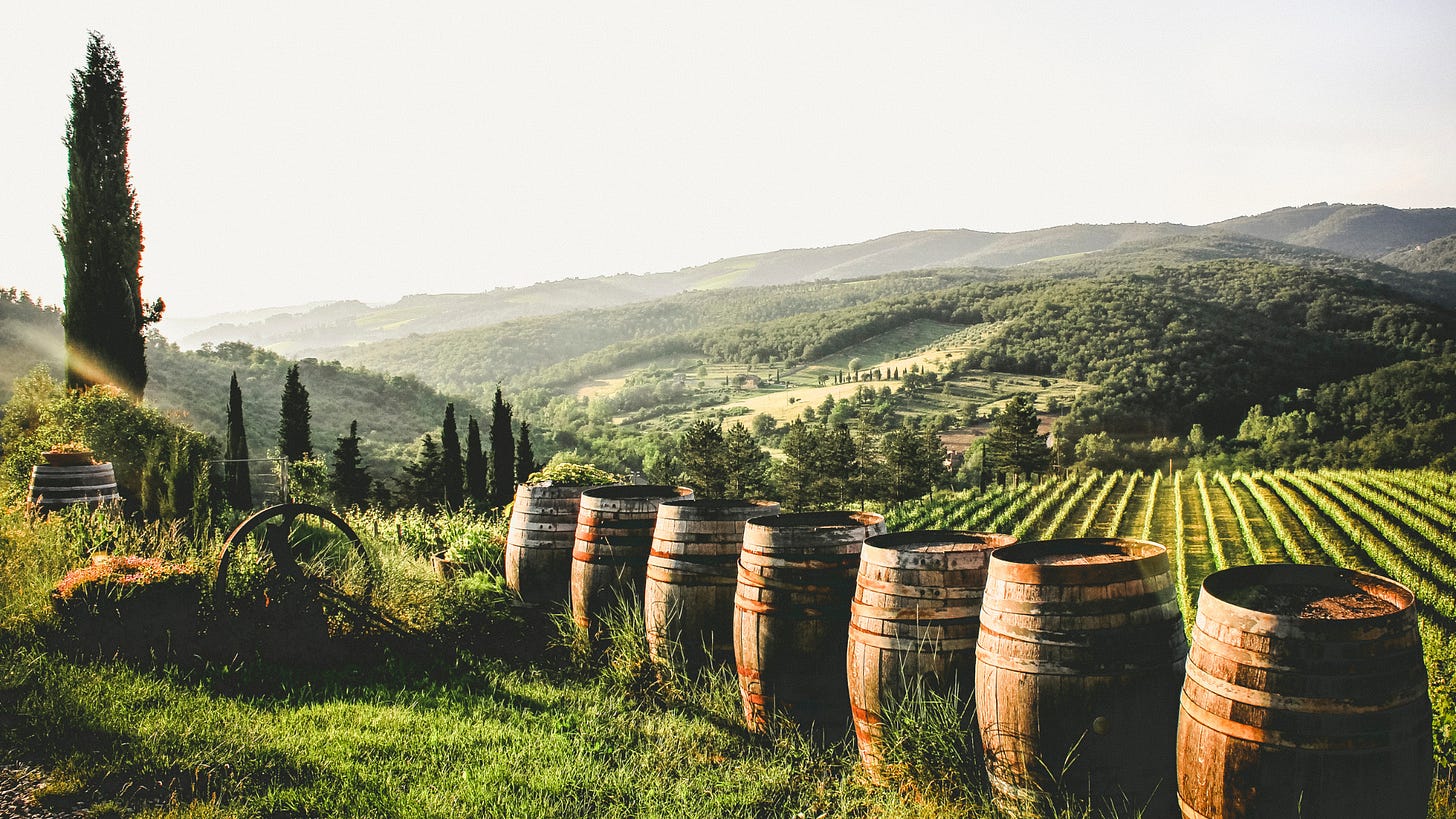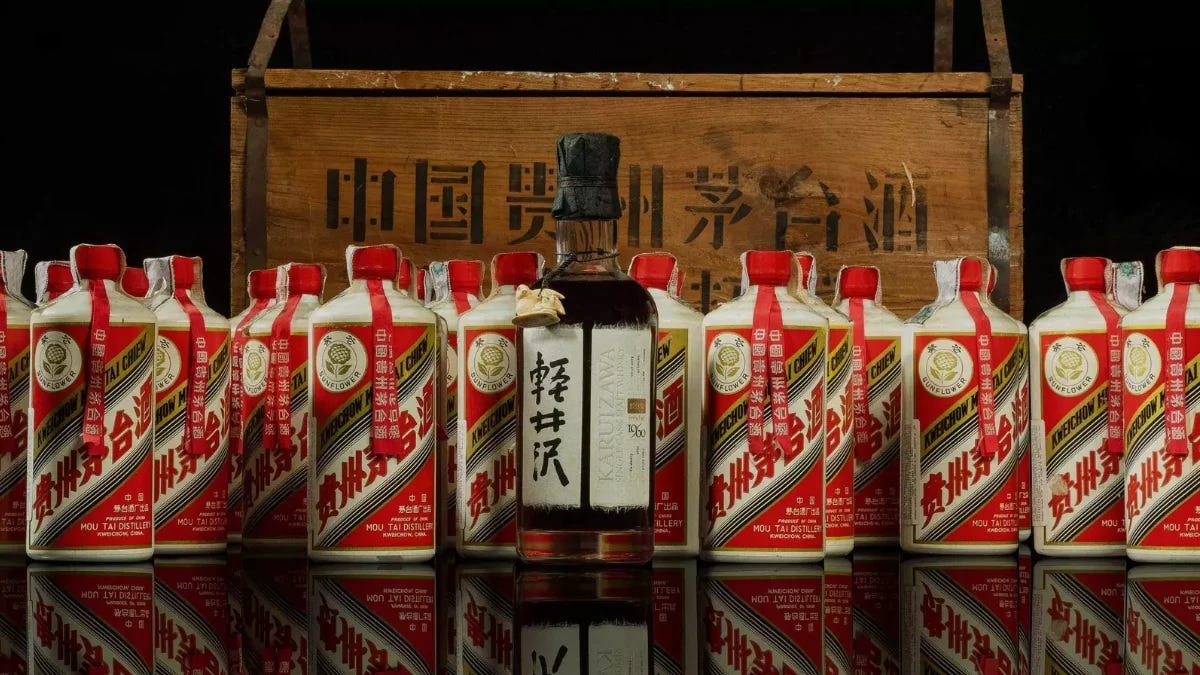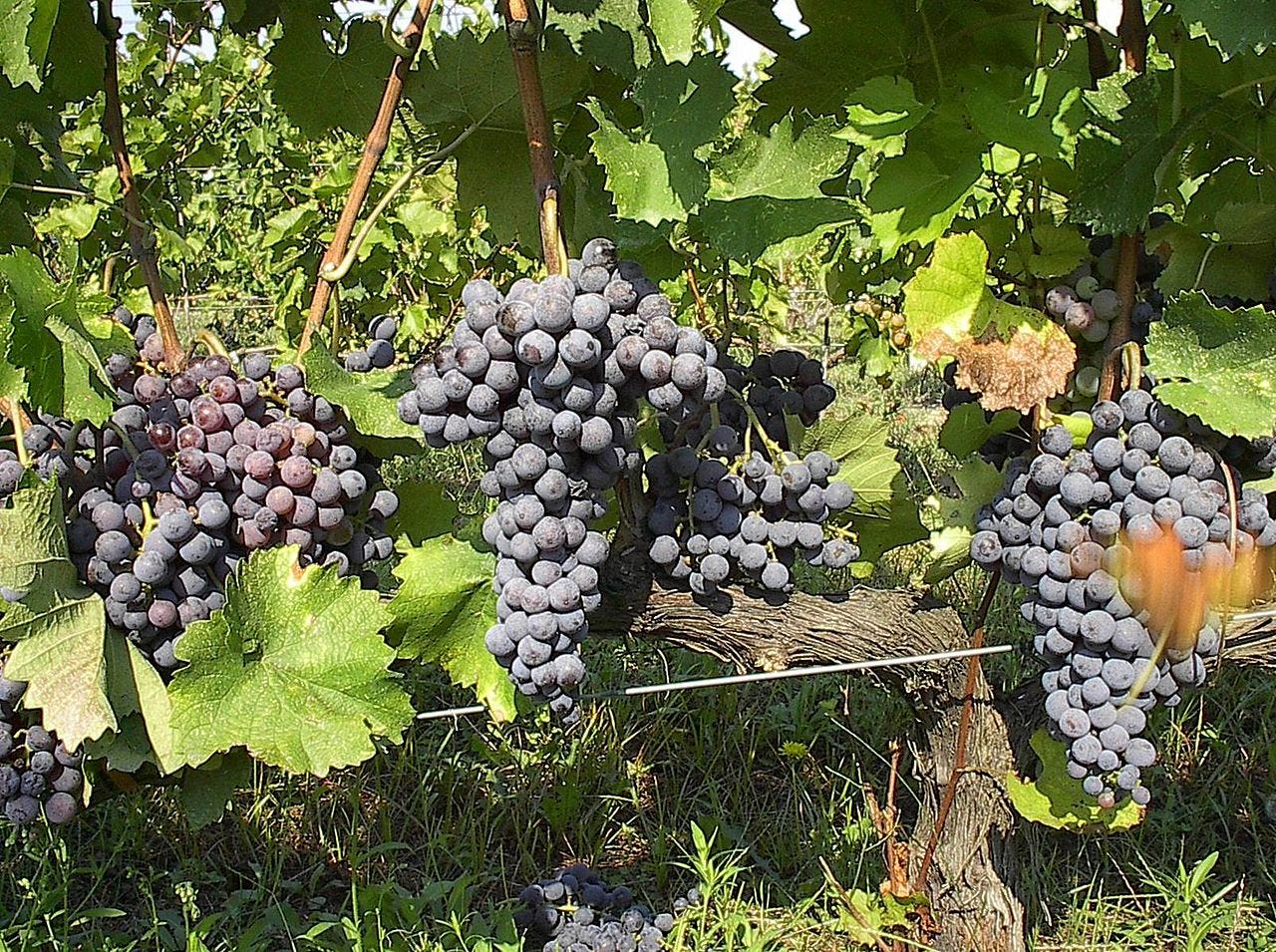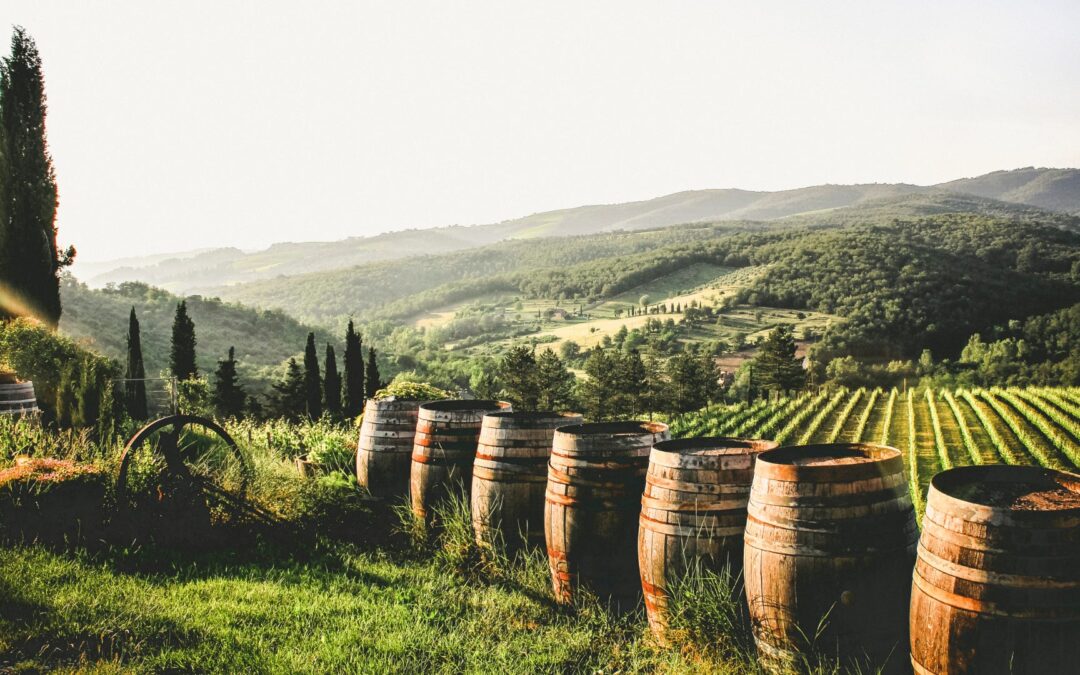
by lspeed | Sep 7, 2025 | WINES: UNCORKING THE MYSTERY
Ever tried Turkish wines? If not, it’s about time to do so. On Turkey’s Aegean coast, the town of Urla is quietly raising its profile in the international wine scene. With a winemaking history dating back over 6,000 years, Urla was once a vital hub in the ancient Ionian city of Klazomenai. Today, it’s experiencing a renaissance, blending millennia-old traditions with cutting-edge innovation to produce wines that are gaining some acclaim.
Urla’s connection to wine stretches deep into antiquity. As early as the 6th century BC, Greek settlers introduced winemaking techniques that had evolved from even older Anatolian civilizations like the Hittites and Phrygians. Historical records suggest that Anatolian wines were traded to Italy and France centuries before those countries developed their own wine cultures. Notably, the Muscat grape, known for its sweet, floral profile, was believed to have originated from this region. Its modern Turkish descendant, Bornova Misketi, remains a signature varietal in Urla today.
Forgotten Grapes
Modern winemakers in Urla are bringing indigenous varietals like Urla Karası, Foça Karası, and Gaydura bak to life. Once nearly extinct, they are being carefully nurtured and reintroduced into production. This commitment to heritage not only preserves ancient flavors but also distinguishes Urla’s wines in an increasingly globalized market.
Tailor-Made Terroir
Urla’s climate is a winemaker’s dream. Long, hot summers are moderated by cool Aegean breezes, and mild, wet winters nourish the vines without stressing them. The region’s mineral-rich soils lend depth and complexity to the wines, while sustainable and chemical-free practices have become the norm. Many wineries have embraced gravity-flow systems to ensure gentle handling of grapes, resulting in wines of remarkable purity and elegance.
Rising Wine Tourism
Urla’s commitment to quality has not gone unnoticed. Wines from the region have begun to win awards at international competitions, positioning Urla as a rising star in viticulture. Meanwhile, the establishment of the Urla Vineyard Route (Urla Bağ Yolu) has transformed the area into a destination for wine lovers, complete with boutique wineries, scenic vineyard walks, and gourmet restaurants. Euphemistically referred to as the “Tuscany of Turkey,” Urla has become a sought-after destination for those seeking authentic wine experiences.
Leading Producers
Among the most celebrated names is Urla Winery, known for its commitment to both local and international varietals. Their flagship wines, like “Tempus”, a robust blend of Merlot, Syrah, Cabernet Sauvignon, Cabernet Franc, and Petit Verdot, and “Nero,” combining Nero d’Avola and Urla Karası, showcase the versatility of the region.
USCA Winery takes a poetic approach, naming its wines after Shakespearean sonnets and working closely with French oenologist Antoine Bastide d’Izard to craft refined offerings. Bornova Misketi and Foça Karası feature prominently in their portfolio.
Urlice Vineyards, pioneers of the modern Urla wine movement since 1997, specialize in organic viticulture and oak-aged reds from Cabernet Sauvignon, Merlot, and Syrah. Their vineyard experiences have made them a favorite among visiting wine enthusiasts.
Other notable players include MMG Winery, known for sustainable farming and night harvesting to preserve grape integrity, and HUS Winery, which fuses Turkish and Chilean traditions to produce elegant Syrah and Grenache wines.
Popular Wine Styles
Red blends dominate Urla’s wine scene, often marrying international varieties like Cabernet Sauvignon, Merlot, and Syrah with indigenous grapes such as Boğazkere and Urla Karası. These reds tend to be full-bodied, expressive, and rich in tannins, balanced by fresh acidity.
On the white side, wines crafted from Bornova Misketi, Chardonnay, and Sauvignon Blanc offer crisp, aromatic profiles perfect for the Mediterranean climate. Rosés are also gaining popularity, especially refreshing blends like Urla Winery’s “Serendias Roze,” made from Pinot Noir and Kalecik Karası.
Image Credit: https://phoenicia.travel/images/tours/288152134228155205297.png
_ _ _
© CHURRASCO PHUKET STEAKHOUSE / ALL RIGHTS RESERVED
Reprinting, reposting & sharing allowed, in exchange for a backlink and credits
Churrasco Phuket Steakhouse serves affordable Wagyu and Black Angus steaks and burgers. We are open daily from 12noon to 11pm at Jungceylon Shopping Center in Patong / Phuket.
We are family-friendly and offer free parking and Wi-Fi for guests. See our menus, reserve your table, find our location, and check all guest reviews here:
https://ChurrascoPhuket.com/
#Churrascophuket #jungceylon #phuketsteakhouse #affordablewagyu #wagyu
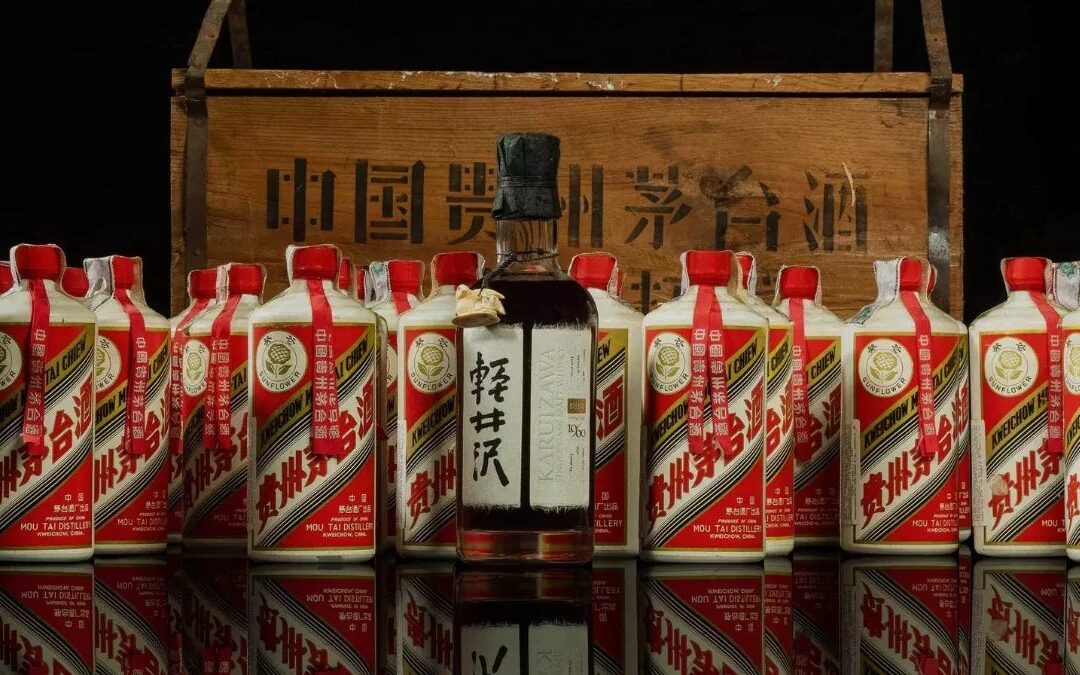
by lspeed | Sep 7, 2025 | LIQUORS: LIFT YOUR SPIRITS
Moutai is not just China’s most iconic liquor, it is a cultural artifact. Its production methods are rooted in tradition, its flavor shaped by geography and time, and its consumption tightly woven into social fabric and political symbolism.
For outsiders, Moutai can be mystifying at first sip. Pungent, bold, and utterly unlike Western spirits. But for those who embrace it, Moutai offers one of the more storied drinking experiences in the world. Whether as a diplomatic tool, a luxury collectible, or a traditional drink passed around a family table, Moutai is an enduring emblem of Chinese cultural identity.
Born in Guizhou, Raised by Dynasties
Moutai’s roots that stretch back over two thousand years. It is produced in the town of Maotai, located in Renhuai City, Guizhou Province, a remote and mountainous region in southwest China. The spirit rose to national prominence during the Qing Dynasty, but its modern incarnation began in 1951 when the state established the Kweichow Moutai Distillery by merging several private producers.
Moutai became a symbol of national pride after it was served during diplomatic banquets, famously toasted by Premier Zhou Enlai during President Nixon’s landmark visit to China in 1972. It has since gained a reputation as China’s “national liquor,” often associated with political functions, state gifts, and elite gatherings.
Composition and Ingredients
Moutai is a type of sauce-aroma baijiu (酱香型白酒), one of the mret complex aroma profiles in the baijiu world. Its primary ingredients are surprisingly simple:
However, what sets Moutai apart is not its raw materials, but its production process, a meticulous, time-intensive cycle involving:
The unique microflora of the Chishui River basin and Guizhou’s warm, humid climate play a vital role in fermentation, much like terroir in wine production. The wheat is used to create a naturally occurring fermentation starter called “qu” (曲), rich in wild yeasts and enzymes. This gives Moutai its trademark umami-driven aroma, often likened to soy sauce, roasted nuts, tropical fruit, and fermented beans—an intense, almost savory profile that takes many by surprise.
Ritual and Reverence
In China, Moutai is more than a beverage, it is a ritual. Its high alcohol content (typically 53% ABV) and powerful aroma mean Moutai is an acquired taste, but once acquired, it’s revered. Served at room temperature in small porcelain cups, it is sipped slowly and ceremonially. Toasting customs are deeply embedded in Chinese culture, and Moutai is frequently consumed at business banquets, weddings, and state functions. Some typical practices:
-
Ganbei (干杯): A full-toast where the entire cup must be downed at once, showing respect and sincerity.
-
Pairing: It is rarely mixed and is usually consumed with food, especially rich, spicy, or umami-heavy dishes.
-
Gift Culture: Bottles of Moutai, especially limited-edition or vintage ones, are commonly given as luxury gifts or bribes, making them both culturally significant and politically sensitive.
From Curiosity to Prestige
Outside China, Moutai is both exotic and enigmatic. Its role in diplomatic gifting continues to raise its profile, and it is now slowly becoming a statement bottle in some global fine spirits circles. In recent years, it has made inroads into global markets, targeting luxury spirits consumers. Kweichow Moutai, the brand’s main producer, is now one of the world’s most valuable liquor companies by market capitalization, surpassing even Diageo at certain points.
However, international acceptance has been mixed:
-
Positive reception in Asia and among Chinese diaspora communities, where cultural familiarity enhances appreciation.
-
Western connoisseurs often struggle with its intense flavor and unorthodox aroma, although some spirits critics have praised its complexity.
-
Moutai has featured in luxury auctions, high-end duty-free shops, and even starred in crossovers like Moutai-flavored chocolates and cocktails at elite bars.
-
Despite limited mass appeal, collectors and investors have embraced it, turning vintage Moutai bottles into speculative assets.
Image Credit: https://www.blueoceanmy.com/wp-content/uploads/2023/12/Exploring-the-Unique-World-of-Maotai-Chinas-Premier-Spirit.png.webp
_ _ _
© CHURRASCO PHUKET STEAKHOUSE / ALL RIGHTS RESERVED
Reprinting, reposting & sharing allowed, in exchange for a backlink and credits
Churrasco Phuket Steakhouse serves affordable Wagyu and Black Angus steaks and burgers. We are open daily from 12noon to 11pm at Jungceylon Shopping Center in Patong / Phuket.
We are family-friendly and offer free parking and Wi-Fi for guests. See our menus, reserve your table, find our location, and check all guest reviews here:
https://ChurrascoPhuket.com/
#Churrascophuket #jungceylon #phuketsteakhouse #affordablewagyu #wagyu
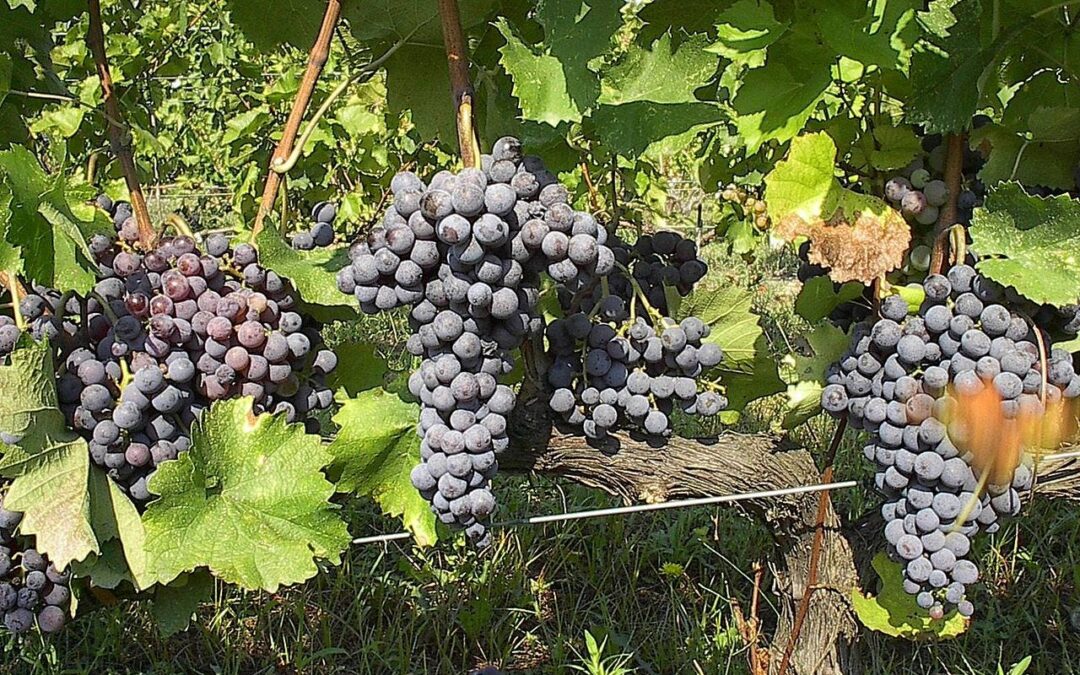
by lspeed | Sep 7, 2025 | DECODING GRAPES: FROM VINES TO VINTAGE
Xinomavro (pronounced ksee-NO-ma-vro), is arguably Greece’s most iconic red grape variety. As such, it holds a special place in the country’s viticultural heritage. Translating to “acid-black,” the name reflects the grape’s defining features: high acidity and deeply pigmented skins that yield powerful, age-worthy wines.
Origins and History
Xinomavro originates from northern Greece, particularly from the region of Macedonia. Its historical roots are deeply tied to Naoussa, a wine region recognized for producing Greece’s first PDO (Protected Designation of Origin) red wine in 1971. Though indigenous to Greece, Xinomavro is often likened to Nebbiolo due to its tannic structure, aging potential, and flavor complexity.
For centuries, this grape has been cultivated in small vineyards scattered across hillsides, thriving in continental climates with cold winters and hot summers. Over time, it became the defining red variety of several key northern Greek appellations.
Geographical Reach
The primary strongholds of Xinomavro are in northern Greece, notably in four PDO zones:
-
Naoussa (Macedonia) – The flagship region, producing 100% Xinomavro wines with long aging potential.
-
Amyndeon (Florina) – At higher elevations with cooler climates, Xinomavro here yields more elegant, aromatic styles and is also used in sparkling and rosé wines.
-
Goumenissa – Typically blended with Negoska, creating softer and fruitier wines.
-
Rapsani (Mount Olympus) – Blended with Krassato and Stavroto, producing complex, medium-bodied wines.
Outside Greece, Xinomavro remains rare but is gaining interest among experimental producers in Italy, the U.S., and Australia, reflecting a growing international curiosity for native Mediterranean grapes.
Wines Produced
Xinomavro is versatile but demanding. The most iconic style is a robust, structured red wine, often made in a traditional, oxidative style with extended maceration and long oak aging. These wines can be austere in youth but develop immense complexity over decades. Aromas of dried tomato, olive, sun-dried fruit, black cherry, and spice are characteristic.
In Amyndeon, Xinomavro is also used in:
-
Rosé wines – Crisp, floral, and lively with red fruit notes.
-
Sparkling wines – A unique expression showcasing its acidity and aromatics.
Modern winemakers have begun experimenting with less extraction and gentler oak aging to produce fresher, more approachable expressions, often labeled as single-vineyard or small-batch bottlings.
Grape and Wine Characteristics
Xinomavro is notoriously sensitive to site, weather, and vineyard management. To dedicated vintners, it is known for its:
Image Credit: https://en.wikipedia.org/wiki/Xinomavro#/media/File:Popolka-Xinomavro.jpg
_ _ _
© CHURRASCO PHUKET STEAKHOUSE / ALL RIGHTS RESERVED
Reprinting, reposting & sharing allowed, in exchange for a backlink and credits
Churrasco Phuket Steakhouse serves affordable Wagyu and Black Angus steaks and burgers. We are open daily from 12noon to 11pm at Jungceylon Shopping Center in Patong / Phuket.
We are family-friendly and offer free parking and Wi-Fi for guests. See our menus, reserve your table, find our location, and check all guest reviews here:
https://ChurrascoPhuket.com/
#Churrascophuket #jungceylon #phuketsteakhouse #affordablewagyu #wagyu
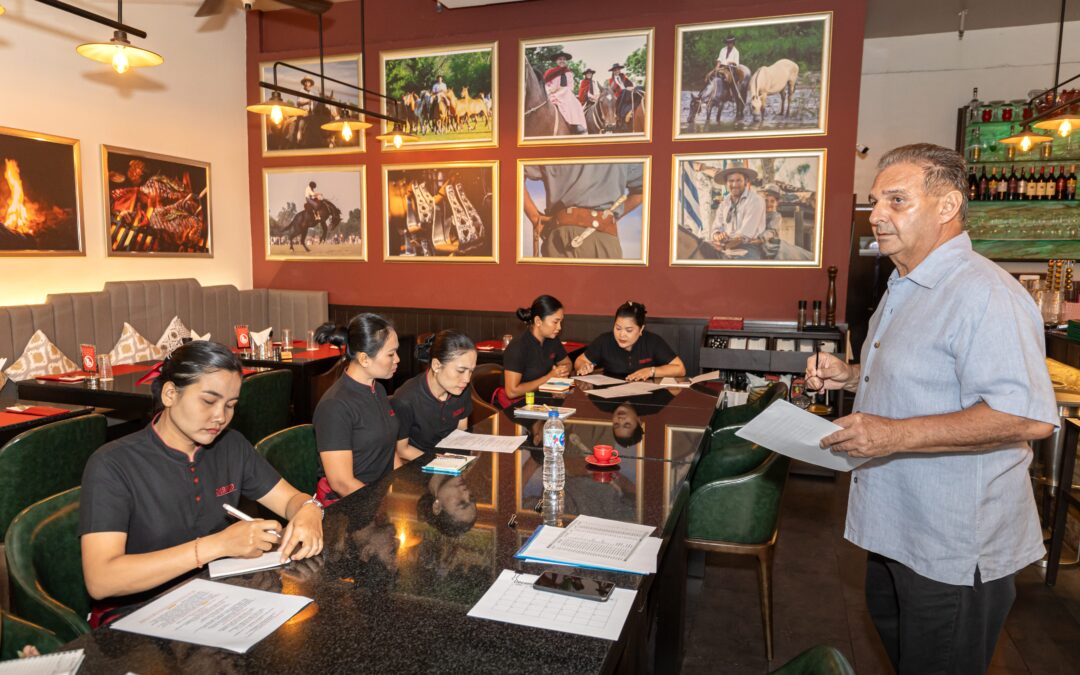
by lspeed | Sep 7, 2025 | RESTAURANT BUSINESS: BEHIND THE KITCHEN DOOR
Restaurant life is fast, often furious. Orders fly in, staff rotate through shifts, customers expect seamless service. It’s a demanding environment, and without consistent communication, even the best teams lose focus. That’s where regular team meetings come in. They’re not about adding bureaucracy; they’re about building alignment, trust, and accountability. Handled well, meetings can strengthen operations and culture. Handled poorly or skipped entirely, they become a missed opportunity or worse, a point of frustration.
Why They Matter
-
Clear Communication
Important updates—like menu changes, allergy alerts, equipment issues, or VIP bookings—need to be communicated clearly and consistently. Relying on shift notes, scattered messages, or word of mouth often leads to confusion. Meetings give everyone the same information at the same time, reducing errors and miscommunication.
-
Team Culture
A regular meeting rhythm fosters team identity. It creates space to acknowledge good performance, share feedback, and build mutual respect. When staff feel included and informed, they’re more likely to buy in—and less likely to burn out or walk away.
-
Reinforcement of Standards
Meetings allow managers to revisit service expectations, health and safety procedures, and brand values in a structured way. Reinforcement is especially useful in environments with high staff turnover or seasonal hires.
-
Feedback and Improvement
The kitchen, floor, and bar staff often have insights that management misses. Meetings provide an opportunity to hear what’s working—and what isn’t. Encouraging open dialogue leads to smarter, faster problem-solving.
Common Pitfalls
-
Bad Timing
Getting everyone in one room can be a challenge. Split shifts, peak prep hours, and deliveries don’t leave much downtime. Scheduling must be realistic—meetings that cut into rest days or cause staff to clock extra hours without purpose can quickly breed resentment.
-
Poor Structure
Meetings that run too long, lack focus, or don’t address day-to-day concerns lose credibility. If staff feel the meeting isn’t relevant to their role or adds no value, they’ll disengage. A vague, one-sided meeting does more harm than good.
-
No Follow-Through
Nothing undermines a meeting more than repeated issues with no action. If feedback is collected, but not acted on—or if promises are made and forgotten—staff will stop contributing. Meetings must result in clear actions and accountability.
How Often?
The ideal frequency depends on the size and nature of the business:
-
Weekly (15–30 minutes): Best for fast-paced restaurants with frequent changes. A short standing meeting early in the week helps set priorities and reinforce focus.
-
Biweekly (30–45 minutes): Works well for mid-size teams or steady operations. Allows time for team input, operational updates, and light training without overloading schedules.
-
Monthly (45–60 minutes): Useful for deep dives—financial performance, staff development, guest feedback trends, or seasonal planning.
-
Daily Pre-Shift Briefs (5–10 minutes): These quick huddles are essential in any operation. They cover the day’s reservations, specials, staffing adjustments, and service notes.
How To Make It Productive
An effective agenda doesn’t need to be complicated. A basic structure helps keep the meeting on track:
-
Welcome and Recognition (3–5 minutes)
-
Operational Updates (10–15 minutes)
-
Menu changes, stopped items, stock concerns, event reminders, service flow adjustments.
-
Training or Focus Topic (5–10 minutes)
-
One skill, standard, or issue to highlight—e.g., how to handle complaints, plating consistency, up-selling techniques.
-
Team Feedback and Questions (5–10 minutes)
-
Next Steps and Closing (3–5 minutes)
Image Credit: https://churrascophuket.com
_ _ _
© CHURRASCO PHUKET STEAKHOUSE / ALL RIGHTS RESERVED
Reprinting, reposting & sharing allowed, in exchange for a backlink and credits
Churrasco Phuket Steakhouse serves affordable Wagyu and Black Angus steaks and burgers. We are open daily from 12noon to 11pm at Jungceylon Shopping Center in Patong / Phuket.
We are family-friendly and offer free parking and Wi-Fi for guests. See our menus, reserve your table, find our location, and check all guest reviews here:
https://ChurrascoPhuket.com/
#Churrascophuket #jungceylon #phuketsteakhouse #affordablewagyu #wagyu
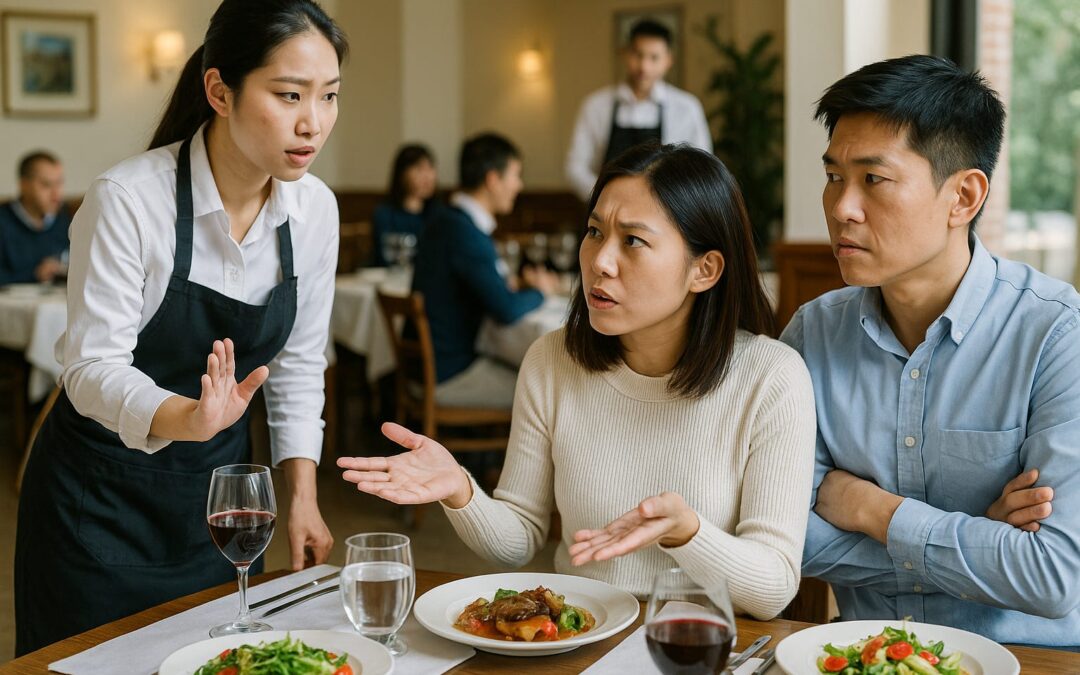
by lspeed | Aug 24, 2025 | BLACK BOX: RANTS, RAVES, REVIEWS & RECIPES
Great hospitality is about controlled magic, not contained mayhem. A team working in sync with a room full of strangers offers the illusion that the entire evening is seamless and effortless. When it works, guests feel looked after without noticing the mechanics behind it. The timing is right, the service unobtrusive, the energy warm. For a moment, they believe the universe revolves around their table and them.
But that illusion rests on an unspoken contract between restaurant and guest. Increasingly, that contract is breaking. Phones and selfies dominate the table. Children wander around the dining room unchecked. Meals are filmed more than they are eaten. Some guests treat restaurants as backdrops for content, others as stages for their own performance. This behaviour isn’t entirely new, but is becoming routine and ever harder to manage.
Once, experienced floor leaders absorbed the friction. A Maître D’ could redirect a situation with authority and charm. A senior server or bartender knew how to diffuse tension before it spread. Today, such professionals are rare, often stretched thin or pulled off the floor entirely. Without them, responsibility falls on less experienced staff who lack both the authority and the support to hold the room together.
The guest’s side of the contract has also shifted. Long before Covid, technology and consumer culture were reshaping expectations. Social media rewards the individual over the collective. The rise of customization, once a hallmark of service, has been warped into the idea that every order should bend entirely to one person’s preferences. After Covid, guests returned impatient, out of practice in social norms, and a lot more entitled. Meanwhile, restaurants returned with leaner teams and less seasoned leadership. The result is a service environment where staff face more disruption but with fewer tools to manage it.
This is where the old mantra, “the guest is always right,” begins to show its cracks. It was never true. Guests can be wrong, misinformed, or simply acting out. What great professionals know is how to make guests feel right without undermining the standards of the house. That requires what might be called benevolent authority, meaning assertiveness wrapped in warmth and professionalism. It’s the skill of setting boundaries with charm. But that skill is impossible to exercise if leadership doesn’t back the team.
Too often, teams are told to “just make them happy.” The default solution becomes comped desserts, apologies on repeat, and giving way to unreasonable demands. Short-term, it defuses the moment. Long term, it drains morale, drives turnover, and erodes the culture and standards. The hidden cost of endless appeasement is not the free dessert but the loss of talented people unwilling to work in a system where their dignity isn’t protected.
Hospitality is not and has never been about servitude, it’s about a skill and balance. A mutual exchange, where the restaurant delivers thoughtful service and the guest brings basic respect for the shared space. When that balance holds, the dining room thrives. When it breaks, staff feel unsupported, standards slip, and the atmosphere turns awkward. Every operator knows the difference between a room humming with conviviality and one that feels like a powder keg waiting for a spark.
For restaurant owners and managers, the path forward is not about doubling down on slogans or tightening rulebooks. It’s about investing in human leadership on the floor. That means training leaders to manage people as much as service flow. It means empowering staff to make judgment calls rather than forcing them into rigid scripts. And most importantly, it means creating a culture where dignity is valued on both sides of the table.
The guest is not always right. But handled properly, they should leave feeling as if they were, because the team was skilled, fully supported, and there confident enough to manage the situation without compromise.
That’s the standard the hospitality trade must recover. Not deference at all costs, but dignity for both guest and team.
Image Credit: https://churrascophuket.com
_ _ _
© CHURRASCO PHUKET STEAKHOUSE / ALL RIGHTS RESERVED
Reprinting, reposting & sharing allowed, in exchange for a backlink and credits
Churrasco Phuket Steakhouse serves affordable Wagyu and Black Angus steaks and burgers. We are open daily from 12noon to 11pm at Jungceylon Shopping Center in Patong / Phuket.
We are family-friendly and offer free parking and Wi-Fi for guests. See our menus, reserve your table, find our location, and check all guest reviews here:
https://ChurrascoPhuket.com/
#Churrascophuket #jungceylon #phuketsteakhouse #affordablewagyu #wagyu


